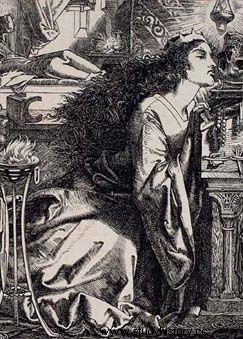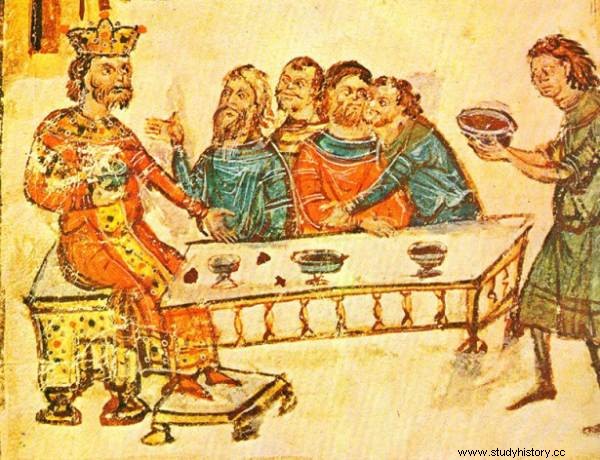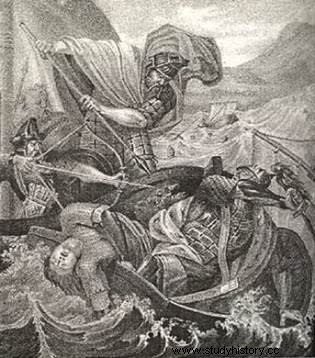Toasty rises on various occasions. The obvious thing is to fulfill them with the help of all kinds of vessels. Quite a specific idea of what the medieval rulers were supposed to drink from. Especially the ruler of the so-called barbarian peoples.
The skull is associated with something dark and disturbing. The gothic atmosphere comes to mind, the famous scene from "Hamlet" or the good old Lady Death. However, it must not be forgotten that the skull (and especially its upper part) is a very tight container for the human brain. If one takes into account this tightness, a certain macabre custom, cultivated by some victorious rulers, starts to seem quite… practical.
There are stories in various corners of Eurasia about using the inverted top of a defeated enemy's skull as a cup. It was drunk at feasts to celebrate victory and all the more to humiliate enemies. Here are some examples.

The Queen of the Lombards Rozamund with the skull of her father.
Lord of the Lombards - Alboin
The Lombards, allied with the Avars, defeated the army of the Gepids. King Alboin (died around 572) himself killed the ruler of the latter. The victorious commander acquired the treasures of the killed Kunimund and took his daughter Rozamunda as a wife.
From the skull of the defeated enemy, Alboin ordered to make a cup, then forced his wife to drink from the skull of her own father. The king of the Lombards paid for his cruelty towards his wife - on the instigation of Rosamund, his squire killed him.
Chagan Pannonian Bulgarians - Krum
After the fall of the Avar state, the Bulgarians broke free from the yoke, and their territory increased. At that time, Krum (died 814) ruled in the capital, and he did not sin with humility or love for high culture. The said leader attacked the lands belonging to Byzantium. Emperor Nikephorus reacted firmly to this, but the real struggle was delayed by two years.
Only then did the emperor begin a victorious march through the lands of the Bulgarians, refusing requests for peace. He chased Krum across the country until he ventured into the mountains. There, the great army of Byzantium was practically wiped off the face of the earth. Nikephorus died, and his wounded heir barely escaped alive. Krum ordered to make a goblet for himself from the skull of the dead emperor. During feasts, he drank from this vessel to his fellow diners.

Emperor Krum and the feast after defeating Nikephor. According to sources, Chagan drank to his companions with a cup from the skull of the ruler of Byzantium ...
Chief of the Pechenegs
When the prince of Kiev Svyatoslav (d. 972) was returning from the Balkans to his lands, he had to overcome the weather on the Dnieper. In those days, they were avoided by traveling by land and boats were pulled ashore for this purpose. Svyatoslav and his entourage acted in a similar way. Then they fell into an ambush set for them by the steppe people of the Pechenegs. The ruler of Rus was killed, and the leader of the Pechenegs made a goblet set in gold from his skull. Supposedly, the words "He lost someone else while looking for his" were engraved on the vessel.
Legend or applied arts?

Prince Svyatoslav a moment before he becomes an element of the tableware.
By comparing these three examples, we can see their distance in time and space. This begs the question:is it not just a legend where places and characters changed depending on where it was told? Or maybe subsequent rulers referred to the macabre tradition established by the leaders who had lived before? There is no way to unequivocally explain this puzzle. Interestingly, all examples come from a single geographic region. Let us add that this extraordinary "applied art" did not disappear with the end of the Middle Ages.
In 1511, Sultan al-Ghawri received a special gift, namely a cup made of a human skull. The donor was Shah Ismail, who killed the Crimean Tatar Khan in a duel. The defeated skull was used as the material for making the vessel, but the recipient's gift was rather disgusting. How was he to enjoy wine from a goblet made of a piece of his former ally?
